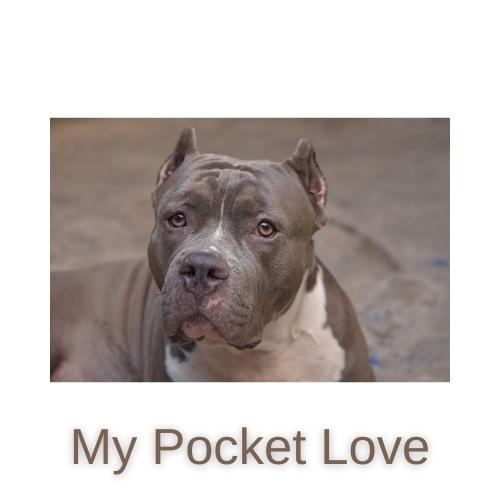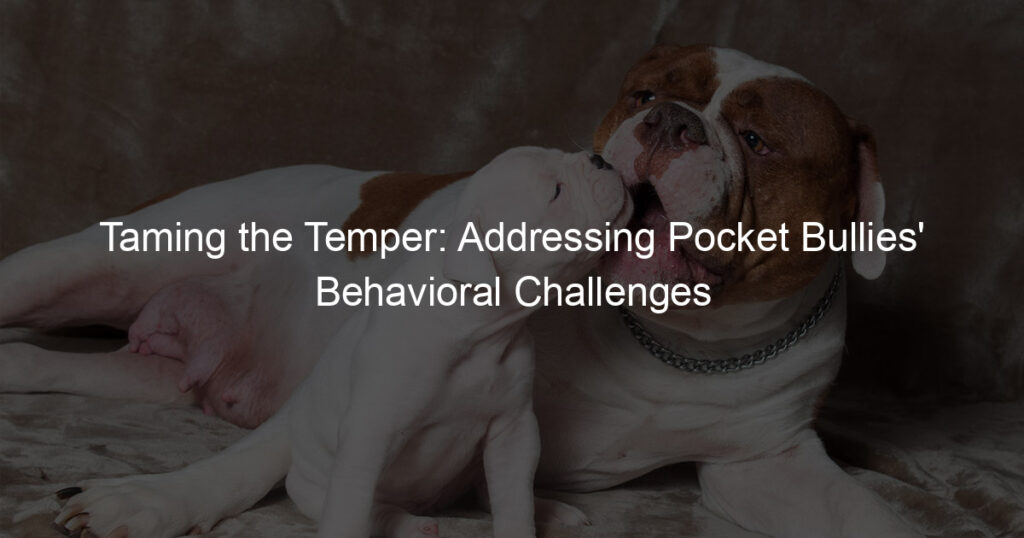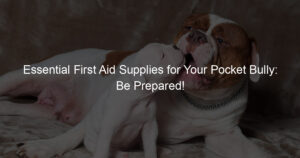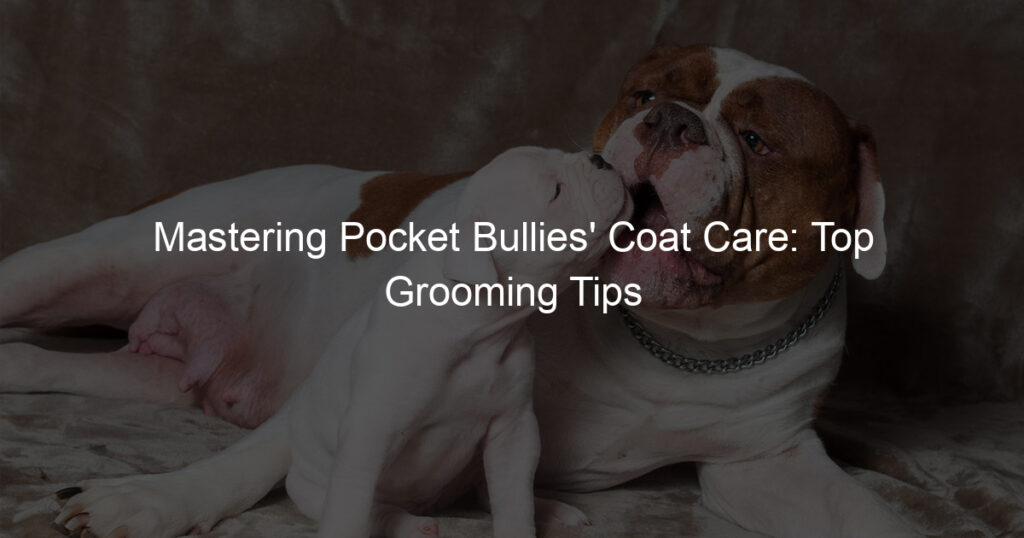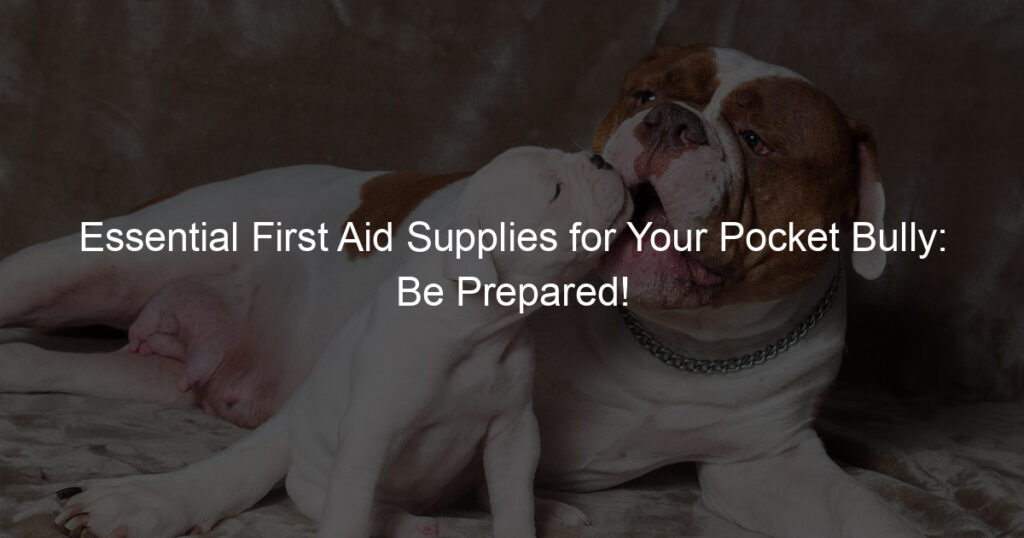
Understanding Pocket Bullies Behavior
Pocket Bullies, a unique breed of dogs, are known for their distinctive behavior traits. Understanding these traits can help you build a better relationship with your Pocket Bully. Let’s delve into what defines this breed, their common behavior traits, and the root causes of any behavioral issues they may have.
- Defining the breed: Pocket Bullies
- Common behavior traits of Pocket Bullies
- Understanding the root causes of Pocket Bullies behavior issues
Pocket Bullies are a type of American Bully, a breed that was developed in the 1980s and 1990s with the aim of creating a family-friendly pet. Despite their intimidating name, Pocket Bullies are known for their friendly and sociable nature. They are called ‘Pocket’ because they are the smallest version of the American Bully, typically standing 12 to 16 inches tall.
Pocket Bullies are known for their loyalty, intelligence, and affectionate nature. They are great with families and show a lot of love for their owners. Despite their tough exterior, they are gentle and friendly dogs. However, like any breed, they can develop behavioral issues if not properly trained or socialized.
| Common Traits | Description |
|---|---|
| Loyalty | Pocket Bullies are extremely loyal to their owners and families. |
| Intelligence | They are smart dogs, capable of learning and following commands quickly. |
| Affectionate | They are known for their love and affection towards their owners. |
Behavioral issues in Pocket Bullies can stem from a variety of factors. Lack of socialization, improper training, or neglect can lead to problems like aggression, anxiety, or excessive barking. It’s important to remember that these issues are not inherent to the breed, but are often a result of the environment and the way they are raised.
In conclusion, understanding your Pocket Bully’s behavior is key to ensuring a happy and healthy relationship with them. By knowing what defines the breed, recognizing their common behavior traits, and understanding the root causes of any behavioral issues, you can provide the best care for your Pocket Bully.
Addressing Pocket Bullies Challenges
Training a Pocket Bully can be a rewarding experience, but it also comes with its own set of challenges. Understanding these challenges and knowing how to address them is crucial for a successful training experience.
Pocket Bullies Training
Training a Pocket Bully requires patience, consistency, and a good understanding of the breed’s unique characteristics. Here are some key aspects to consider:
- Importance of early socialization:
- Effective training methods for Pocket Bullies:
- Addressing aggression and dominance in Pocket Bullies:
Early socialization is crucial for Pocket Bullies. It helps them to become well-adjusted adults. Exposing your Pocket Bully to different environments, people, and other animals at a young age can help them become more comfortable in various situations. According to the American Kennel Club, puppies should begin socialization before they are 12 weeks old.
Positive reinforcement is one of the most effective training methods for Pocket Bullies. This involves rewarding good behavior with treats, praise, or playtime. It’s also important to be consistent with your commands and to train in short, frequent sessions to keep your Pocket Bully’s attention.
While Pocket Bullies are generally known for their friendly and outgoing nature, they can sometimes show signs of aggression or dominance. It’s important to address these behaviors early on. If your Pocket Bully shows signs of aggression, it’s important to remain calm and assertive. Never punish your dog physically as this can lead to more aggressive behavior. Instead, redirect their energy into something positive like a game or a training session.
Remember, every Pocket Bully is unique and may require different training techniques. What works for one may not work for another. It’s important to be patient and consistent, and to always end training sessions on a positive note.
Managing Pocket Bullies Behavior
Managing the behavior of Pocket Bullies can be a challenging task, but with the right approach, it can be made easier. Here are some key strategies to help you manage your Pocket Bullies behavior effectively:
- Establishing boundaries and rules
- Importance of consistency in training
- Dealing with stubbornness in Pocket Bullies
Just like children, Pocket Bullies need boundaries and rules to guide their behavior. This helps them understand what is expected of them and what is not acceptable. For instance, you might establish a rule that your Pocket Bully is not allowed on the furniture. This rule should be enforced consistently to ensure your dog understands and respects it. Remember, boundaries and rules not only keep your dog’s behavior in check but also provide them with a sense of security.
Consistency is key when it comes to training Pocket Bullies. This means that the rules you establish should be enforced all the time, not just occasionally. If you allow your dog to break the rules sometimes, they will get confused and might not follow the rules at all. For example, if you have a rule that your dog is not allowed on the bed, you should stick to it, even when you feel like cuddling with your dog on a cold night. Consistency in training helps your dog understand what is expected of them, which makes managing their behavior easier.
Pocket Bullies can be quite stubborn, which can make training a bit challenging. However, with patience and persistence, you can overcome this challenge. When your dog is being stubborn, it’s important not to give in to their demands. Instead, stand your ground and insist on what you want them to do. For instance, if your dog refuses to get off the couch, don’t give up and let them stay. Instead, insist on your command until they obey. Over time, your dog will learn to follow your commands, even when they are being stubborn.
Remember, managing your Pocket Bullies behavior is not about being harsh or punitive. It’s about setting clear expectations and being consistent in enforcing them. With patience, consistency, and love, you can effectively manage your Pocket Bullies behavior and enjoy a harmonious relationship with them.
Pocket Bullies Discipline
Disciplining your Pocket Bullies is an essential part of their upbringing. It helps them understand their boundaries and behave appropriately. Let’s delve into some of the common behavior problems Pocket Bullies might exhibit and how to address them.
Pocket Bullies Behavior Problems
- Common behavior problems in Pocket Bullies
- How to address these problems effectively
- Case study: Successful behavior correction in a Pocket Bully
Pocket Bullies, like any other breed, can exhibit certain behavior problems. These can include excessive barking, chewing, digging, and aggression. These behaviors are often a result of boredom, lack of exercise, or insufficient training.
Addressing these behavior problems requires patience and consistency. Start by identifying the root cause of the problem. For instance, if your Pocket Bully is chewing excessively, it might be due to teething or boredom. Provide them with chew toys or increase their exercise routine to help curb this behavior. If aggression is the issue, consider seeking professional help from a dog behaviorist.
Let’s consider the case of Max, a Pocket Bully who was exhibiting aggressive behavior. His owner, Sarah, noticed that Max’s aggression was primarily directed towards other dogs. She sought help from a professional dog behaviorist, who suggested a combination of obedience training and socialization exercises. After several weeks of consistent training, Max’s aggression significantly reduced. He started interacting more calmly with other dogs, demonstrating that with the right approach, behavior problems in Pocket Bullies can be effectively addressed.
Remember, every dog is unique and what works for one might not work for another. It’s important to understand your Pocket Bully’s individual needs and temperament to effectively address their behavior problems.
Pocket Bullies Behavior Management
Managing the behavior of Pocket Bullies requires a blend of positive reinforcement, exercise, and mental stimulation. These elements are essential for maintaining a balanced and well-behaved pet. Let’s delve into each of these aspects.
- Importance of Positive Reinforcement
- Role of Exercise and Mental Stimulation in Behavior Management
- Key Takeaways for Managing Pocket Bullies Behavior
Positive reinforcement is a powerful tool in managing the behavior of Pocket Bullies. It involves rewarding good behavior, which encourages the dog to repeat it. For example, when your Pocket Bully follows a command, a treat or praise can reinforce this positive behavior. This method is more effective and humane than punishment, and it strengthens the bond between you and your pet.
Exercise and mental stimulation play a crucial role in managing Pocket Bullies’ behavior. These dogs are energetic and intelligent, requiring regular physical activity and mental challenges to keep them happy and well-behaved. Daily walks, playtime, and puzzle toys can help meet these needs. Without adequate exercise and mental stimulation, Pocket Bullies may become bored and exhibit problematic behavior.
Managing the behavior of Pocket Bullies is not a one-time task but a continuous process. Remember to consistently use positive reinforcement to encourage good behavior. Regular exercise and mental stimulation are also vital to keep your Pocket Bully content and well-behaved. With patience and consistency, you can cultivate a strong bond with your Pocket Bully and enjoy a harmonious relationship.
| Behavior Management Aspect | Importance |
|---|---|
| Positive Reinforcement | Encourages good behavior and strengthens the bond between you and your pet. |
| Exercise and Mental Stimulation | Keeps your Pocket Bully content and well-behaved, preventing problematic behavior. |
Additional Tips for Pocket Bullies Behavior Correction
While understanding and addressing the behavior of Pocket Bullies is crucial, there are additional factors that can significantly influence their behavior. Let’s explore these factors:
- Importance of a Balanced Diet
Just like humans, Pocket Bullies need a balanced diet to stay healthy and happy. A balanced diet provides the necessary nutrients that help in maintaining their energy levels, keeping their coat shiny, and supporting their overall health. When your Pocket Bully is healthy, they are more likely to exhibit positive behavior.
Include a variety of proteins, carbohydrates, fats, vitamins, and minerals in their diet. Avoid feeding them human food as it may contain ingredients that are harmful to dogs. Always consult with your vet to determine the best diet plan for your Pocket Bully.
- Role of Regular Vet Check-ups
Regular vet check-ups play a vital role in your Pocket Bully’s behavior. Health issues can often lead to changes in behavior. For instance, a dog suffering from pain may become aggressive or anxious. By taking your Pocket Bully for regular vet check-ups, you can ensure they are in good health and prevent any potential health-related behavior issues.
During these check-ups, the vet can also provide valuable advice on managing your Pocket Bully’s behavior and training them effectively.
- Importance of Patience and Understanding
Patience and understanding are key when it comes to correcting your Pocket Bully’s behavior. Remember, behavior correction doesn’t happen overnight. It’s a process that takes time and consistency.
Understanding your Pocket Bully’s needs and behavior patterns can help you address their behavior issues more effectively. Be patient with them and reward their good behavior to encourage positive habits. Remember, your Pocket Bully is not just a pet, but a member of your family who deserves love and understanding.
In conclusion, a balanced diet, regular vet check-ups, and a patient and understanding approach can go a long way in correcting your Pocket Bully’s behavior. Always remember, a healthy and happy Pocket Bully is more likely to exhibit positive behavior.
